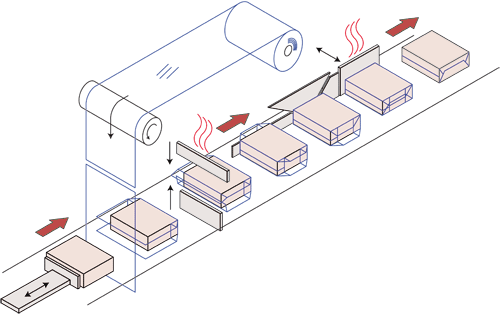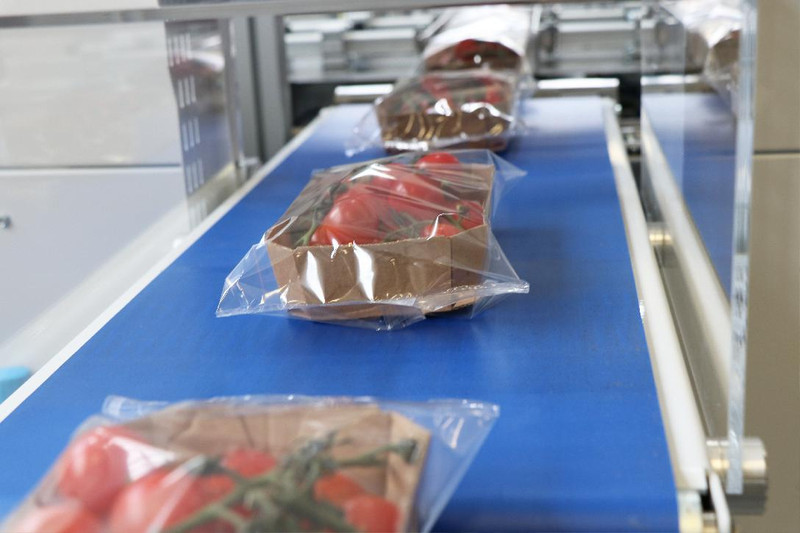Posted by Mike Cunningham on Nov 14th 2024
Overwrapping and Flow Wrapping what is the Difference?
Despite their similarity in name, flow wrapping and overwrapping are distinct packaging techniques; they package different types of products, employ different equipment, and achieve different functions. Here we describe each process and the differences between them.
Flow Wrapping, also sometimes referred to as pillow pouch wrapping, horizontal bagging, and fin-seal wrapping, is a horizontal-motion packaging process used to cover products—with any geometric shape—in clear or custom-printed polypropylene film. The finished package is a flexible packet featuring a crimped seal on each end.
The flow wrapping process employs the use of flow wrapping machines, which are designed and manufactured to package a wide range of products to achieve varying aesthetic looks and feels. Using these machines, the following operations occur:
-Placement of the products on an infeed conveyor belt.
-Transportation of the products to the forming area.
-Wrapping of the product(s) with sealing material.
-Mating of the outer edges of the material along the bottom.
-Creation of a tight seal between the mated edges using pressure, heat, or both.
-Movement of the products through rotating cutter edges or end seal crimpers to seal both ends and separate individual packets from one another.
-Discharge of the packaged products for storage and/or further packaging operations.
Overwrapping: is only used to wrap and seal products with flat sides—such as boxes, cartons, and trays—in heat sealable film. The result is a packaged product wrapped and sealed, much like a gift. The process is suitable for adding secondary packaging over already packaged products to preserve freshness and combining individually packaged products together.
Like flow wrapping, overwrapping makes use of specialized equipment—i.e., overwrapping machines. These machines perform the following operations:
-Pushing the product through heat sealable film cut from a larger roll.
-Folding the film around the product.
-Heat sealing the film at the overlapping sections.
-Forming the envelope-like ends with shaped plates and sealing them using heated plates or belts.
-Discharging the packaged products for storage and/or further packaging operations.
Differences Between Flow Wrapping and Overwrapping
When deciding between the flow wrapping and overwrapping for a packaging operation, it is important to keep in mind their differences. For example, flow wrapping accommodates products of all shapes, while overwrapping is suitable only for products with flat sides. Additionally, flow wrapping is used to protect products from damage and degradation, while overwrapping allows for the combination of multiples packages into a single unit for easier storage and delivery.
Which Method Should You Choose? Both flow wrapping and overwrapping offer unique advantages, but there are times when it is clearly best to use one over the other. Below we outline some of the key benefits and applications of each packaging technique.
Some of the benefits of using the flow wrapping method to package products include:
Broad size tolerance: Flow wrapping accommodates a variety of product shapes and sizes.
Airtight seals: The seals formed by the flow wrapping process keep out air and moisture to preserve the freshness of the packaged products, resulting in longer shelf lives.
Easy set-up operations: With flow wrapping machines, it is easy to adjust for different product parameters, including in regard to size and shape.
For the above reasons, among others, flow wrapping is widely used across industry. It is often used by the food and beverage, medical, pharmaceutical, and tool and hardware industries to package their goods, such as candy bars, baked goods, soaps, lotions, and duct tape.
Overwrapping offering many manufacturing advantages, such as:
Versatility: Overwrapping can be used in several ways, including serving as the primary packaging for the products, as a method of bundling separate products into a single multi-pack unit, or as further protection for already packaged products.
Attractiveness: Overwrapping creates a sleek packaged look.
Tamper-proofing: As overwrapping requires specialized equipment to apply correctly, it is obvious if it has been tampered with or removed.
Compound control: Overwrapping keeps out contaminants (allowing for longer shelf life) and keeps in internal compounds (helping contain strong odors).
Many consumer industries make use of overwrapping. Some of the most common include the food and beverage, healthcare, and personal care industries, which use the process to package goods such as frozen meat, boxes of tea, paper towels, cold medicine, and lipstick.

Flow wrapping and overwrapping each have their place in packaging operations, and, at Quick Pak Inc, we are well-versed in both methods. Call us at 813 242 6995 or reach out to sales@quickpakinc.com

